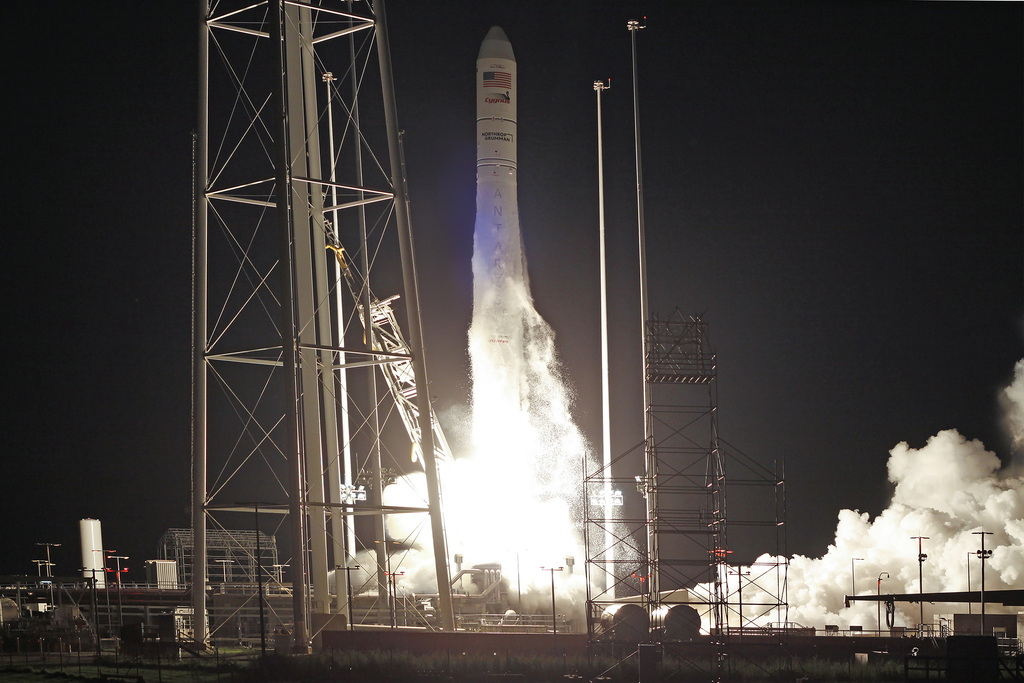Northrop Grumman Corporation has successfully launched its 19th resupply mission (NG-19) to the International Space Station (ISS) under NASA’s Commercial Resupply Services-2 (CRS-2) contract aboard the company’s Antares rocket. This launch commemorates ten years of Northrop Grumman Cygnus missions.
ISS Resupply: A Payload of Progress
The NG-19 mission is carrying an impressive cargo of over 8,200 pounds, comprising equipment, scientific experiments, and essential supplies destined for the ISS crew.
Over the past ten years, the Cygnus spacecraft has delivered a cumulative payload of approximately 130,000 pounds to sustain and enhance the capabilities of the space station’s occupants.
Investigating Fire Safety in Microgravity

One of the most intriguing aspects of this mission is the inclusion of NASA’s Spacecraft Fire Safety Experiment (Saffire) aboard the Cygnus spacecraft. This experiment aims to unravel the mysteries of fire growth in microgravity conditions. It was established to investigate large-scale flame growth and material flammability limits in space.
The experiments are ignited in Cygnus cargo spacecraft after they complete their primary International Space Station supply missions, depart the station, and before their planned destructive reentries through Earth’s atmosphere.
Understanding how fire behaves in microgravity, and how different materials propagate flames in space is immensely important for the development of future crew spacecraft. It also will help inform operational protocols for dealing with fire emergencies, particularly when astronauts do not have the ability to exit a spacecraft or quickly return to Earth.
Critical insights gained from the mission will help to shape the design of future human spaceflight endeavors. By understanding how fires behave in space, engineers can develop safer spacecraft and protocols to ensure the well-being of astronauts.
The Cygnus Spacecraft
Steve Krein, Northrop Grumman’s vice president for civil and commercial space, emphasizes the significance of the Cygnus spacecraft in supporting ISS resupply missions. Since the inaugural mission in 2013, Northrop Grumman has continuously enhanced the spacecraft’s capabilities.
This evolution has led to improvements in cargo mass capacity and additional functionalities such as the ability to assist in reboosting the ISS’s orbit, underscoring its adaptability and value.

NG-19’s launch took place from the Mid-Atlantic Regional Spaceport located at NASA’s Wallops Flight Facility on Wallops Island, Virginia. Beyond the launch itself, Northrop Grumman plays a pivotal role in the manufacturing of key components for successful mission execution.
These components include spacecraft structures, propellant tanks, UltraFlex solar arrays, and loop heat pipe radiators, all of which are integral to the functionality and performance of the missions.
Honoring a Legacy: Laurel Clark
An endearing tradition of Northrop Grumman is the practice of naming each Cygnus spacecraft after individuals who have significantly contributed to human spaceflight. For the NG-19 mission, the Cygnus spacecraft bears the name of Laurel Clark, a remarkable individual who served as a NASA astronaut, medical doctor, United States Navy captain, and Space Shuttle mission specialist.
Laurel Clark was a member of NASA Astronaut Group 16, chosen in 1996, and she participated in Space Shuttle Mission STS-107. Tragically, she lost her life along with six fellow crew members during the Columbia shuttle disaster, an event that is commemorated this year, marking its 20th anniversary.
Northrop Grumman’s Contributions
Northrop Grumman’s contributions extend beyond individual missions; the company stands as a leader in global aerospace and defense technology. With a commitment to pushing the boundaries of human exploration, Northrop Grumman equips its customers with groundbreaking solutions that enable connectivity, protection, and advancement on a global scale. With a workforce of 95,000 dedicated individuals, Northrop Grumman embraces challenges to redefine what is possible on a daily basis.

